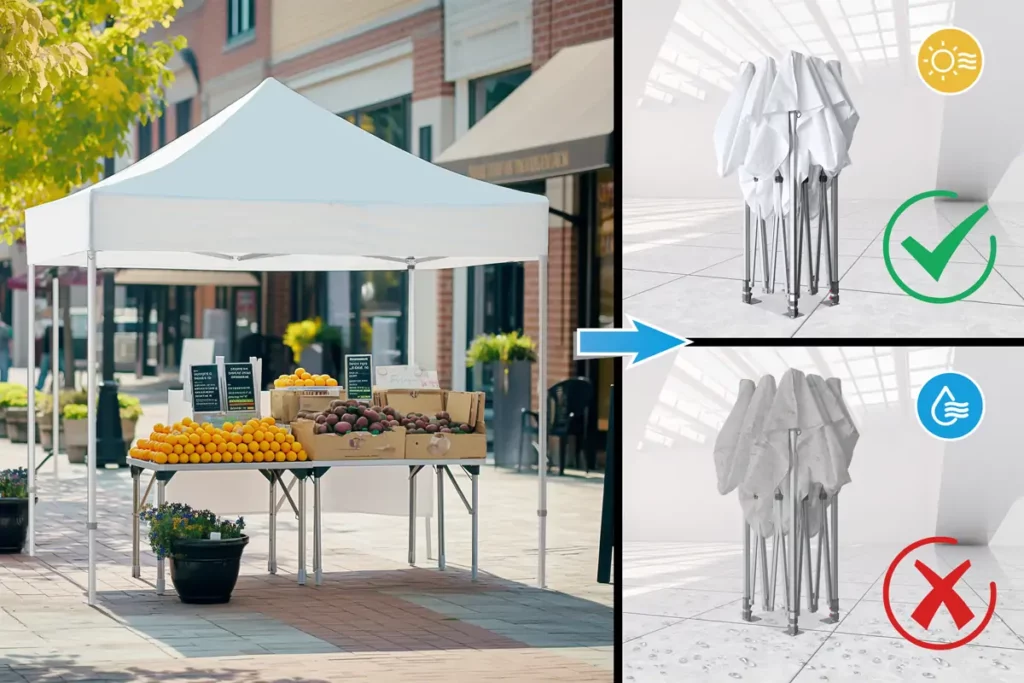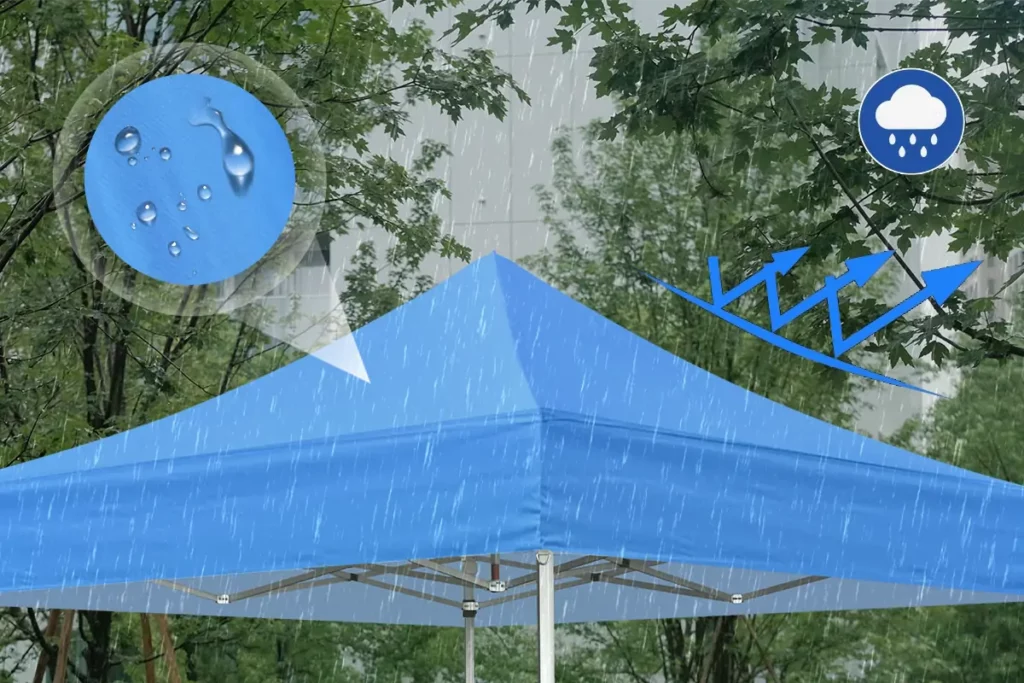
Are you looking for a premium custom canopy tent for your brand event or outdoor exhibition? A well-designed tent can make you stand out from the crowd. However, the process of choosing, using, and maintaining a tent is filled with potential pitfalls. Many people end up wasting time and money due to common misunderstandings.
The good news? Most of these headaches are preventable. In this guide, we’ll break down 9 common mistakes people make with custom canopy tents and provide practical solutions. Follow these tips, and you’ll avoid common setup hassles, prevent costly damage, and keep your tent ready for every event.
Section I: Misconceptions About Choosing a Custom Canopy Tent
Mistake 1: Picking the Wrong Size
This is one of the most common errors. Many people only roughly estimate the size based on the venue, without considering what they actually need for the event. A 10×10 canopy tent might be perfect for a farmer’s market booth, but too small for a trade show with multiple displays. On the other hand, a 20×20 tent looks impressive but can be heavy, bulky, and difficult to manage without enough help. The wrong size can leave you short on space for exhibits, promotional materials, or staff, and could even violate venue regulations.
How to Fix It:
- Think about how much space your products, tables, and staff will realistically need.
- Measure the event location in advance and leave room for walking areas and add-ons like sidewalls or banners.
Mistake 2: Believing Only Fabric Thickness Ensures Durability

Many buyers assume that a thicker canopy fabric automatically lasts longer. While fabric density (measured in denier, like 500D) is important, it’s not the only factor. A thick canopy without UV protection will fade quickly under the sun. Without proper waterproofing, even heavy fabric can let rain seep through the seams. And if the stitching or tension points aren’t reinforced, the material may start tearing at the corners after just a few setups.
In other words, thickness alone doesn’t guarantee durability. What really matters is the overall construction of the tent: the coating, stitching, reinforcement, and quality of materials working together.
How to Fix It:
- Look for protective coatings. Choose the right canopy material with UV resistance to prevent fading and waterproof coatings to protect against rain.
- Inspect seams and corners. Double stitching, heat-sealed seams, and reinforced stress points add strength where it matters most.
- Balance weight and portability. Thicker fabrics are heavier; make sure you can transport and set them up without hassle.
- Also consider the tent frame. A strong frame and canopy work together; heavy fabric won’t help if the frame can’t handle wind or stress. You can check our detailed guide on how to choose the right tent frame for more tips.
Mistake 3: Expecting Printed Colors to Match Online Exactly

Custom printing is a major advantage of branded canopy tents, but expecting the on-screen colors to match the final product exactly is a frequent error. Screens use RGB color mode, while printers work in CMYK, which means some color variation is unavoidable. Another issue comes from logo quality. Low-resolution files may look fine on your laptop, but when enlarged to cover a canopy roof or wall, they can appear blurry, pixelated, or distorted.
How to Fix It:
- Specify Pantone colors when possible. Share Pantone (PMS) codes with your supplier for more consistent results. While an exact match on fabric isn’t always possible, Pantone provides a reliable reference point to minimize surprises.
- Use vector or high-resolution files. Logos and graphics in formats like AI, EPS, or PDF scale cleanly without losing sharpness.
- Understand acceptable variation. A slight color shift is normal in fabric printing. The key is to work with a supplier who sets clear expectations upfront and provides reliable after-sales support if issues arise.
Mistake 4: Ignoring Printing Quality
When evaluating a custom canopy tent, many people focus on the frame’s strength and the fabric’s material, but they completely overlook one critical factor: printing quality. It’s easy to assume that once your design is on the fabric, it will last indefinitely. Unfortunately, this is a common and costly mistake. Low-quality ink or poor printing techniques may fade, crack, or peel faster than the fabric, making your tent look old before the material is actually worn.
How to Fix It:
- Go beyond just looking at the design and asking about the printing method and ink type. Techniques like dye sublimation bond ink directly to the fibers, producing vibrant, long-lasting colors.
Westshade provides both dye sublimation and digital printing for each custom canopy. They produce more accurate and consistent color results on polyester fabrics. Learn more about our types of printing.
Section II: Pop Up Tent Problems During Use
Mistake 5: Assuming Pop Up Tents Are Always Easy to Set Up
Pop-up tents are designed for convenience, so many people assume they require no effort at all. In reality, larger models can be heavy, and improper handling can lead to pinched fingers, bent poles, or misaligned connectors.
How to Fix It:
- Practice before your event. Set up the tent once at home or in a safe area to familiarize yourself with the mechanism.
- Ask for help. Even a small team of two can make lifting and locking the frame easier and safer.
- Follow the tent setup instructions carefully. Pay attention to locking buttons, roof connectors, and tension straps to avoid damage.
Mistake 6: Relying Only on the Frame for Wind Resistance
Many people assume that a sturdy frame alone can withstand strong winds. The truth is, the quality of frames on the market varies greatly. Many standard tents use lightweight or thin metal that may bend or collapse under stress, while poorly designed connectors and plastic joints can fail in windy conditions.
However, even the best frame cannot resist wind on its own. Without proper anchoring, tents can tip, slide, or collapse, potentially damaging the canopy, equipment, or nearby people. Using tent weights not only adds mass to secure your setup but also increases the contact area with the ground, making the entire structure more stable and wind-resistant.
How to Fix It:
- Always secure your tent. Use sandbags, weights, or ground stakes regardless of weather. For more tips on proper anchoring, check out our guide to keep your pop-up tent grounded.
- Choose a tent with an engineered, durable frame.
A high-quality frame, like the ones from Westshade, provides a reliable foundation. For example, our canopy tents adopt an all-metal frame structure built with reinforced aluminum or steel and engineered joints. This design eliminates weak plastic components and ensures maximum stability and durability. For event professionals, our Y7 Heavy-Duty Aluminum Canopy Tent delivers exceptional strength for frequent use. For ultimate reliability, the Y8 Lifetime Aluminum Canopy offers maximum durability and a lifetime warranty, is a premium option designed to withstand years of demanding use.
Mistake 7: Worrying Only About Leaks, Not Water Pooling
You might be concerned about your tent leaking, but another, more serious issue is water pooling. When it rains, if the tent fabric is not taut or is poorly designed, water can collect on the top. A sagging, wet canopy looks unprofessional and can give a poor impression at your event. More? The weight of this water can put immense pressure on the frame, causing the tent to collapse. This problem is especially common with larger tents, flat roof tents, or setups where tension wasn’t applied correctly.
How to Fix It:
- Ensure proper tension. Pull the fabric taut across all corners so water runs off naturally.
- Monitor during rain. Check the roof periodically and gently remove any standing water with a soft broom or mop.
- Choose designs wisely. Peaked canopy designs reduce water pooling and improve stability in wet conditions.
Westshade custom canopies are designed with peaked and tension-optimized roofs, which naturally prevent water pooling and enhance structural stability. Extra stitching and reinforced corners prevent tearing, even under the pressure of standing water. Combined with durable frames and high-quality fabric, our tents stay secure and professional-looking even in heavy rain.

Section III: Maintenance & After-Sale Misunderstandings
Mistake 8: Storing and Transporting Without Care
A tent’s lifespan is also determined by how you store and transport it. Many people put their tents away without cleaning and drying them, which can lead to mold, odors, and fabric damage. Rough handling during transport can also cause scratches, dents, or misaligned connectors.
How to Fix It:
- Clean and dry before storing. Always remove dirt, debris, and moisture from the fabric and frame.
- Fold carefully. Follow the manufacturer’s instructions to fold the canopy and frame to minimize stress on materials.
- Use protective bags or cases. A padded storage bag or hard case prevents scratches, dents, and other transport damage.
- Handle with care. Avoid dragging the tent on rough surfaces or stacking heavy items on top of it.
Mistake 9: Assuming All Parts Have the Same Warranty
It’s easy to assume that the entire canopy, including frame, fabric, and accessories, is covered under the same warranty. In reality, different components often have different coverage periods and conditions. For example, frames may have a 5–10 year warranty, while fabric and printed graphics may have a shorter 1–3 year coverage. If you don’t read the warranty terms carefully, unexpected repair or replacement costs may arise when you need after-sales service.
How to Fix It:
- Read the warranty thoroughly. Understand what’s covered, for how long, and under what conditions.
- Check each component separately. Clarify coverage for the frame, canopy fabric, printed graphics, and accessories.
- Keep documentation. Save receipts, warranty cards, and photos in case you need to make a claim.
- Follow care guidelines. Proper use and maintenance often affect warranty validity.
Make Your Custom Printed Canopy Tent with Westshade
For a hassle-free experience and a canopy that performs in any weather, Westshade custom tents combine durable frames, high-quality fabrics, tension-optimized roofs, and professional printing options. Whether you need vibrant, brand-accurate graphics or a sturdy structure that withstands wind and rain, our tents are designed to look sharp and last for years. Learn more about our custom canopy tent options to create a tent that’s both eye-catching and built to last.








